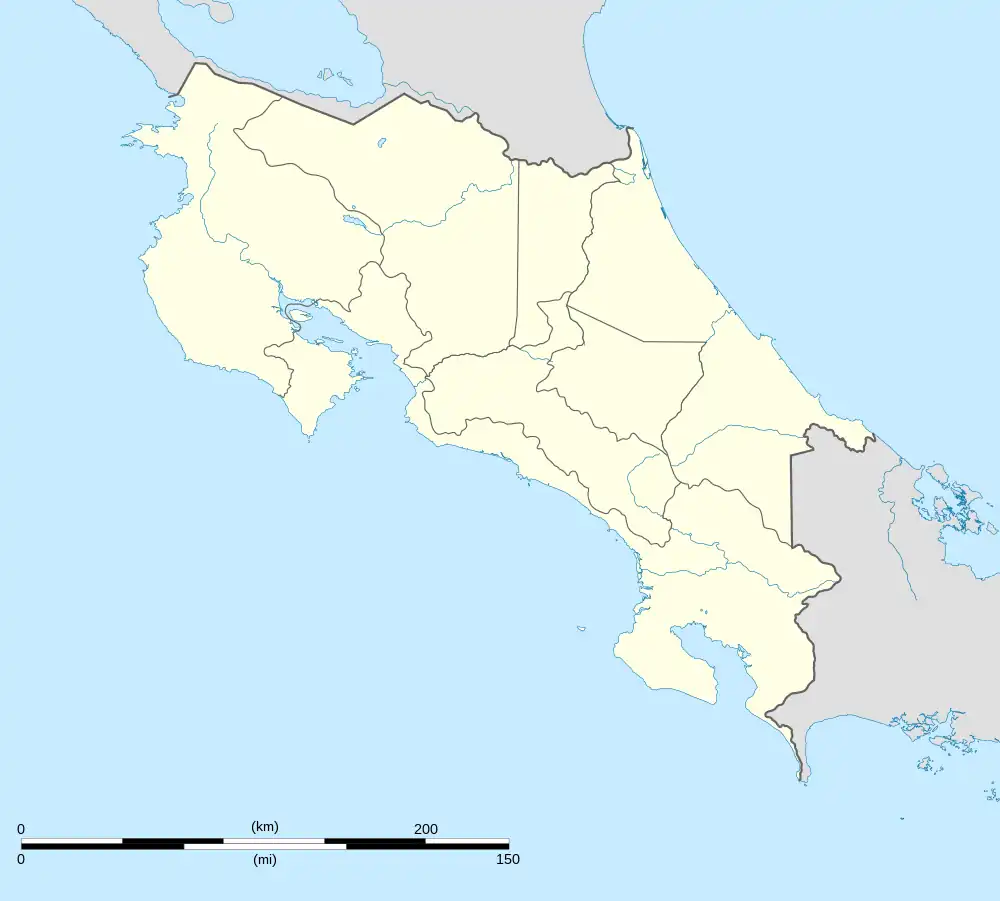Aguas Zarcas | |
|---|---|
Aguas Zarcas district | |
 Aguas Zarcas Aguas Zarcas district location in Costa Rica | |
| Coordinates: 10°25′20″N 84°21′19″W / 10.4222943°N 84.3553697°W | |
| Country | |
| Province | Alajuela |
| Canton | San Carlos |
| Area | |
| • Total | 185.86 km2 (71.76 sq mi) |
| Elevation | 489 m (1,604 ft) |
| Population (2011) | |
| • Total | 20,239 |
| • Density | 110/km2 (280/sq mi) |
| Time zone | UTC−06:00 |
| Postal code | 21004 |
Aguas Zarcas is a district of the San Carlos canton, in the Alajuela province of Costa Rica.[1][2]
Toponymy
The name of Aguas Zarcas, comes from the hot spring waters that could well be called "Aguas de azul suave".
History
From 1800, Germans, Italians and Spaniards formed the ancestors of Aguas Zarcas, the same ones that founded the Spanish colony.
Its colonizers were in charge of carrying out bites in the mountain to facilitate the arrival to the inhabitants that came from Villa Quesada looking for a place where to live.
Geography
Aguas Zarcas has an area of 185.86 km2[3] making it the eighth district of the canton by area and an elevation of 489 metres.[1]
It is located at an elevation range of 100 to 2100 meters above sea level.[4]
This great variation of altitude is due to the fact that in the South of the district are the mountain foothills of the Central Mountain Range, whereas in a northerly direction, the territory follows a clear descent towards the plains of San Carlos.
It is located in the northern region of the country. It borders the districts of Cutris to the north, La Palmera to the west, Pital and Venice to the east. While to the south it borders with the canton of Sarchí.
Its head, the city of Aguas Zarcas, from where it has an excellent view of the hills of the Juan Castro Blanco National Park, is located 16.6 km (30 minutes) NE of Quesada, and 88.4 km (2 hours 20 minutes) to the NW of San José the capital of the nation.
Demographics
| Historical population | |||
|---|---|---|---|
| Census | Pop. | %± | |
| 1927 | 1,914 | — | |
| 1950 | 2,980 | 55.7% | |
| 1963 | 5,097 | 71.0% | |
| 1973 | 4,095 | −19.7% | |
| 1984 | 6,052 | 47.8% | |
| 2000 | 13,651 | 125.6% | |
| 2011 | 20,239 | 48.3% | |
|
Instituto Nacional de Estadística y Censos[5] |
|||
For the 2011 census, Aguas Zarcas had a population of 20,239 inhabitants making it the second most populated district in the canton. [7]
Transportation
Road transportation
The district is covered by the following road routes:
Locations
The 17 population centers of the district are:
- Aguas Zarcas (head of the district)
- Altamira
- Caño Negro
- Cerro Cortés
- Concepción
- Coope-San Juan
- Esquipulas
- Garabito
- La Caporal
- La Gloria
- Los Chiles
- Los Lotes
- Los Angeles (Las Delicias)
- Montecristo
- Pitalito
- Santa Fe
- San Jose
Art and sport
The district is home to one of the country's Civic Centers, which are special sports and recreational areas, promoted by the government and supported by private entities, to promote citizen coexistence through art and sport.
Culture
Every year there are popular festivals in the community, where there are mechanical games and bullfights. Also must be mentioned a kind of horse riding call El Tope, in which the riders wear their best clothes on their colorful horses.
Economy
Poultry has an important presence, with chicken farms distributed throughout the district.
Local crops of cassava and pineapple (along with citrus production from other districts) focused on exports form the basis of the local agroindustry, represented by processing plants and packing of tropical fruits and tubers.
In the city of Aguas Zarcas, there are health, educational, financial, legal, lodging, post, car repair and construction services. Entertainment services are also offered with synthetic courts, gyms, swimming pools and nightlife venues.
In terms of trade, the sale of fast foods, groceries, shoes, clothes, appliances and accessories in general stands out. Also vegetables, chicken meats and milk produced locally are brought to the center to be sold at different points of sale.
Tourist sites
The district shares hot mineral springs with the neighboring district of La Palmera.
References
- 1 2 "Declara oficial para efectos administrativos, la aprobación de la División Territorial Administrativa de la República N°41548-MGP". Sistema Costarricense de Información Jurídica (in Spanish). 19 March 2019. Retrieved 26 September 2020.
- ↑ División Territorial Administrativa de la República de Costa Rica (PDF) (in Spanish). Editorial Digital de la Imprenta Nacional. 8 March 2017. ISBN 978-9977-58-477-5.
- ↑ "Área en kilómetros cuadrados, según provincia, cantón y distrito administrativo". Instituto Nacional de Estadística y Censos (in Spanish). Archived from the original on 24 October 2020. Retrieved 26 September 2020.
- ↑ "Situational diagnosis of the Canton of San Carlos" (pdf). Municipality of San Carlos.
- ↑ "Instituto Nacional de Estadística y Censos" (in Spanish).
- ↑ "Sistema de Consulta de a Bases de Datos Estadísticas". Centro Centroamericano de Población (in Spanish).
- ↑ "Censo. 2011. Población total por zona y sexo, según provincia, cantón y distrito". Instituto Nacional de Estadística y Censos (in Spanish). Retrieved 26 September 2020.